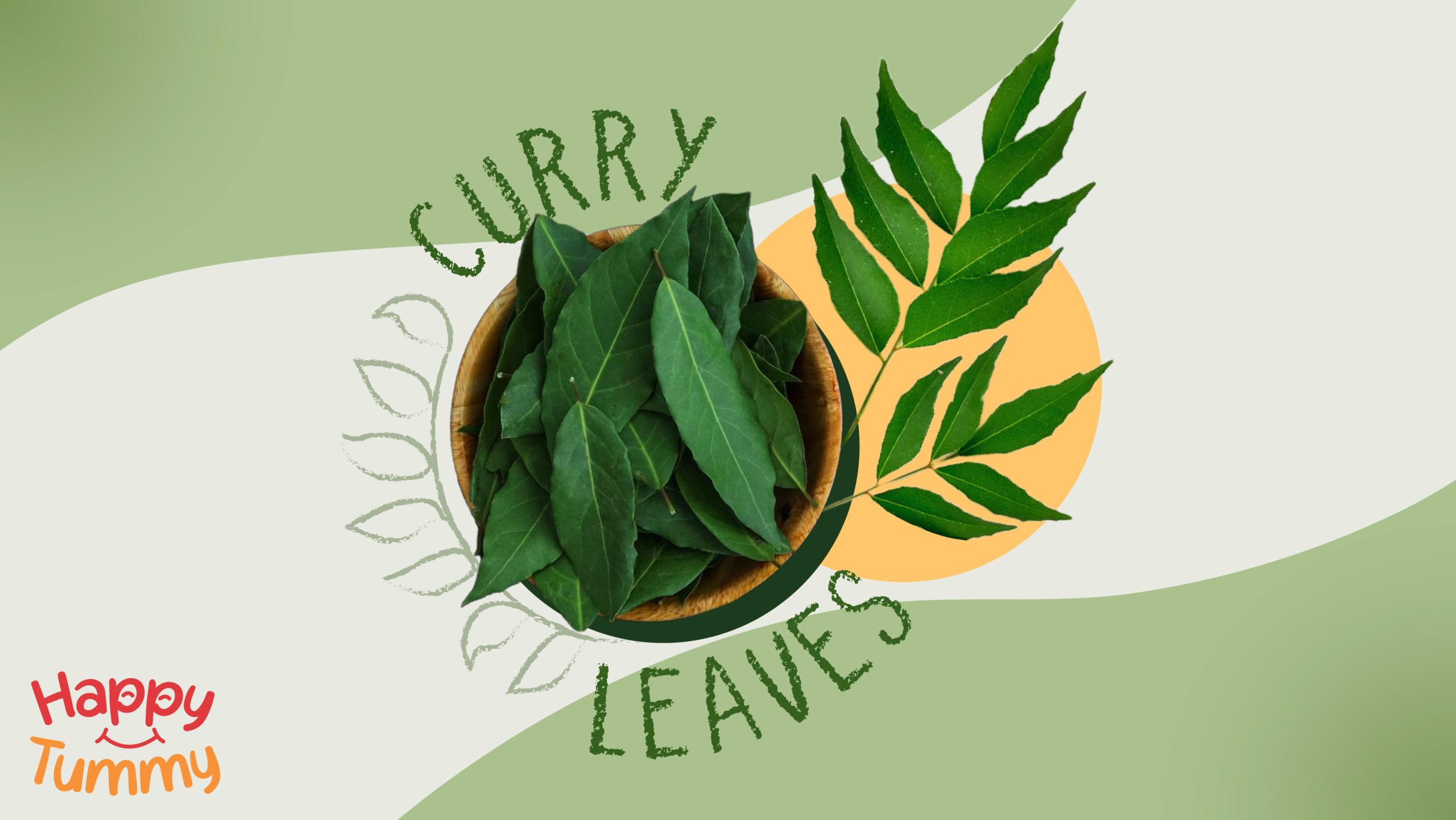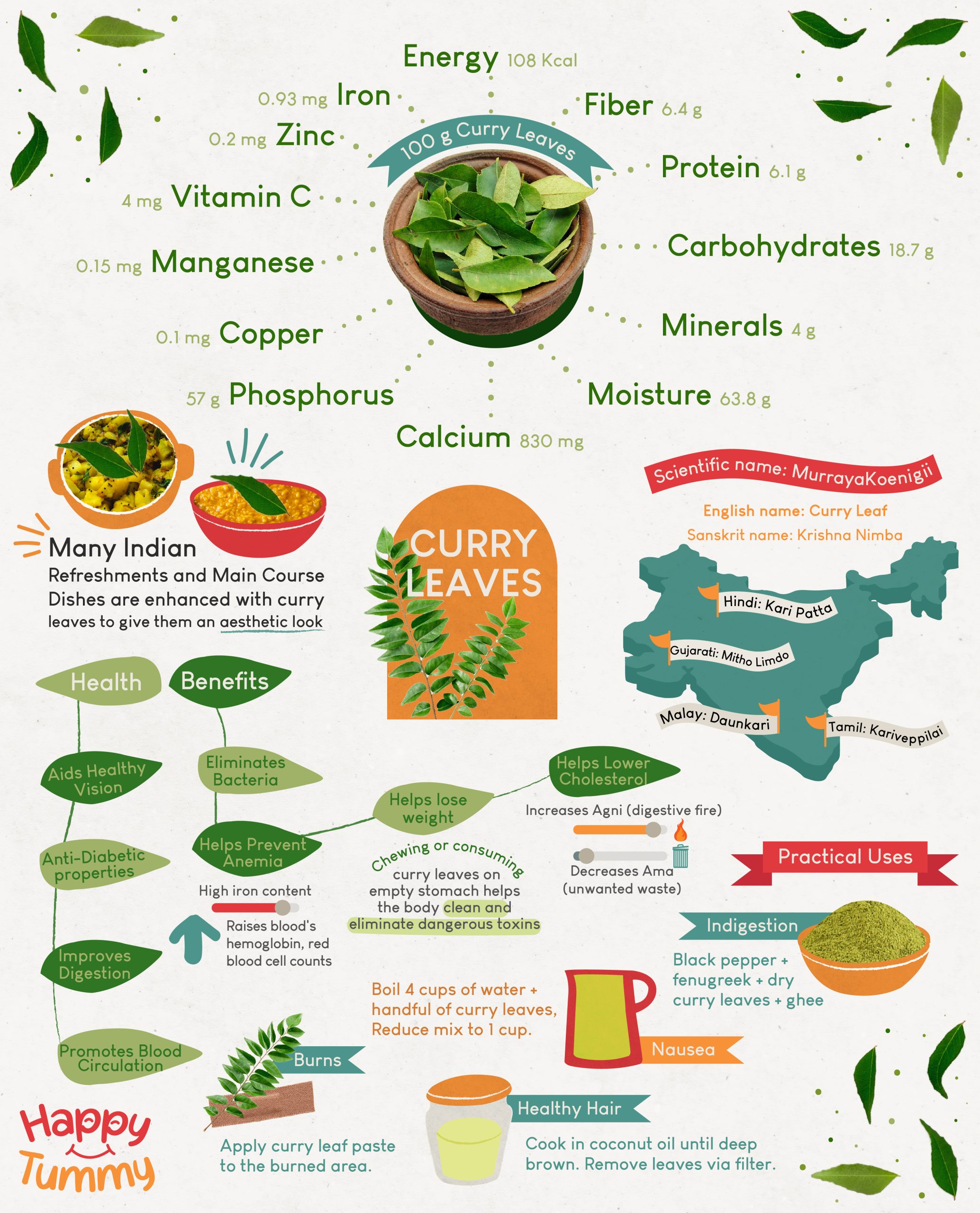Table of Contents
Other than coriander, if you’ve ever frequently noticed a green leaf in Indian food, it was undoubtedly a curry leaf. Many Indian refreshments and main course dishes are enhanced with curry leaves to give them an aesthetic look. Their nutritional benefits are no less!
Unaware of those benefits, I used to pick them out upon uncovering them in our food when I was a child, but now after learning the health benefits, I never deny eating them. You can cut them into tiny chunks so as to prevent kids from making a stack on the corners of their plates.
So, knowing about curry leaves is worth it when everybody surrounding us seems to emphasize natural treasures!!
Curry leaves are flavourful, versatile tiny leaves that can elevate even the most basic dishes, like upma or poha, to the level of foodies’ delight. They are an essential component of the Indian diet since they enhance the food’s particular flavour and aesthetic appeal.
Murraya Koenigii is the official scientific name for curry leaves. Of course, this is not a common name for it! It is known by several distinct names, including:
• Hindi name: Kari patta
• Tamil name: Kariveppilai
• Gujarati name: MithoLimdo
• Malay name: Daunkari
• Sanskrit name: Krishna Nimba
• English name: Curry Leaf
Currying flavours with Curry Leaves
Curry leaves have a strange tangy taste and a pleasant, spicy scent, making it hard to define their taste. When you cook with them, they release a nutty fragrance with hints of citric or slightly bitter taste, yet they have a strong flavour when you chew into one. Cooking with them is the only way to really experience their tang because they are frequently added to simmering tadka, either whole or diced, releasing their unique fragrance.
Because it prefers a warm environment, the curry plant thrives better in tropical areas. You can simply cultivate them in your garden or backyard and enjoy fresh leaves all year. If you reside in a region with a cooler environment, you may plant it in a container to bring it inside during the winter.
Curry leaves are glossy and have a deep green hue. Additionally, curry powder and leaves are entirely different and cannot be used in place of one another! Since it is essential to the Asian meals that call for them, any cook who appreciates these delicacies makes sure to store them on board. Learn everything there is to know about the uses, storage, and delight of curry leaves by scrolling down!
What Nutrients Do Curry Leaves Have?
Curry leaves are brimming with natural nutrients, including vitamins A, B, C, and B12. In addition, these leaves are a fantastic source of calcium and iron. Adding them to your dishes regularly might organically boost your immunity and prevent many deficits.
Per 100 grams, it has the following nutritional values:
| Energy | 108.000 K cal |
| Carbohydrates | 18.700 gm |
| Moisture | 63.800 gm |
| Fiber | 6.400 gm |
| Protein | 6.100 gm |
| Minerals | 4.000 gm |
| Calcium | 830.000 mg |
| Phosphorus | 57.000 mg |
| Iron | 0.930 mg |
| Copper | 0.100 mg |
| Magnesium | 44.000 mg |
| Zinc | 0.200 mg |
| Manganese | 0.150 mg |
| Vitamin C | 4.000 mg |
Thus per serving of curry leaves which may be around 8 to 10 leaves, contains .06 grams of proteins, 1.08 grams of calories, 0.18 grams of carbohydrates, and 0.09 grams of iron, providing excellent nutritional value.
| Calories | 1.08 gm |
| Carbohydrates | 0.18 |
| Protein | 0.06 gm |
| Iron | 0.09 |
What are the Health Benefits of Curry Leaves?
Even though the humble curry leaf contains many beneficial nutrients like protein, fiber, calcium, vitamins, and minerals, as well as exceptional capabilities, we frequently discard it. Here are a couple of reasons why it should likely be a staple of the regular intake and should be enjoyed with the cuisine made with it.
1. Do Curry Leaves Lower Cholesterol Levels?
It offers qualities that reduce the concentrations of cholesterol in your blood. Curry leaves, rich in antioxidants, stop the oxidation of cholesterol that produces LDL cholesterol (bad cholesterol). This prevents atherosclerosis (buildup of fats on artery walls) and heart diseases and increases the quantity of “good” cholesterol (HDL).
The digestive fire, or Pachak Agni, is out of balance and is the cause of high cholesterol. Impaired digestion at the tissue level produces excess waste products or Ama (toxic remains in the body due to improper digestion). This causes the accumulation of bad cholesterol and blockage in the blood vessels. Curry leaves help your body digest food better and eliminate harmful waste.
When ingested consistently, curry helps to improve digestive fire enzymes and decrease unnecessary waste.
2. Curry Leaves Improve Digestion
Since ancient times, it has been used for its ability to aid in digestion. According to Ayurveda, kadipatta contains mild laxative effects (stool softening) that aid the stomach in eliminating extra waste. It promotes bowel movement and activates digestive enzymes when ingested on an empty stomach, which can help you reduce constipation. For optimal effects, consume 8 to 10 raw curry leaves per day on an empty stomach.
3. Curry Leaves Promote Hair Growth
It works wonders on damaged hair, giving it a bounce, strengthening the fragile strands, and preventing hair from falling out. On top of that, you can expect good relief in fungal scalp infections, including the most common dandruff issue.
As curry leaves have a lot of protein, they can be your best buddy when it comes to healthy hair development and entire mane maintenance. Likewise, it contains beta-carotene and amino acids, which also assist in stopping hair loss by strengthening hair follicles, regenerating latent follicles, and encouraging new hair growth.
4. Curry Leaves for Healthy Vision
Well, the abundance of Vitamin A works well for healthy vision. Vitamin A insufficiency can result in night blindness, visual loss, and veil formation. The leaves, therefore, safeguard the retina and guard against eyesight loss.
The presence of carotene in curry leaves can relieve your eyesight, but they are not replacements for any medication. You can only consider them natural and alternative options to maintain a healthy vision- organically and naturally.
5. Curry Leaves Eliminate Bacteria
Every other illness is brought on by an infection or involves reactive cellular damage. Effective treatments are essential in the modern world when the prevalence of antibiotic-resistant bacteria is steadily increasing, and curry leaves have that potential. It is rich in substances with anti-inflammatory, antibacterial, and antioxidant activities.
The chemical alkaloid, which gives these shrubs their floral scent, can also eliminate pathogens and cell-damaging free radicals.
6. Curry Leaves Aid in Weight Loss
Being one of the most efficient ways to remove the body’s stored fat, it is a great plant to utilize to reduce weight. Studies show that curry leaves can lower triglycerides (a kind of fat) and cholesterol levels, preventing obesity.
Regularly chewing or consuming curry leaves on an empty stomach can help the body clean and eliminate dangerous toxins. At the same time, it also helps you lose weight by burning calories and preventing fat storage.
Mahanimbine, an alkaloid found in it, has anti-obesity and fat-lowering properties.
7. Curry Leaves Promote Blood Circulation
Incorporating it into one’s everyday diet helps treat menstruation problems and diarrhea and relieve aches.
8. Curry Leaf’s Anti-Diabetic Properties
Curry leaves, which are abundant in antioxidants like beta-carotene and vitamin C, have the power to prevent many ailments, including type-2 diabetes and heart disease. Pancreatic cells that make insulin can also be activated, giving solace to diabetic patients.
9. Curry Leaves Phase-Out Tiredness
Curry leaves are high in iron and folic acid, which helps the body produce more hemoglobin and red blood cells. Thus, regular consumption can reduce weariness and fading of exhaustion.
10. Are Curry Leaves Good for Skin Care?
Due to their abundance of antioxidants and Vitamin C, it promotes beautiful and healthy skin. It guards against sun damage to the skin. Cook and preserve 30 to 40 fresh leaves in coconut oil. Regular skin massages with this oil can help to stave off wrinkles, lighten dark under-eye bags, and other aging symptoms. Adding a few drops of this oil to your usual skincare routine helps stop infections brought on by blisters, blemishes, and acne.
How Are Curry Leaves Used?
Curry leaves are most frequently used for cooking, particularly when seasoning dals or stews. Before adding any other ingredients, they are commonly combined with diced peppers and cumin seeds.
Moreover, they can be diced finely or left whole and incorporated into chutneys and salads. Be it a tadka or the main meal, it must always be gently cooked in oil before being added to any dish.
This helps release their flavor and essence before adding other ingredients.
Practical Applications
• Puking spurred on by acidity: Powder the stem, combine it with cold water, and ingest.
• Powder dried for constipation: Take one teaspoon of the powder twice daily with one teaspoon of honey.
• For indigestion: Blend black pepper, fenugreek, and dry curry leaves. The powder should be mixed with ghee and consumed daily.
• For diarrhea: Prepare curry leaf juice and take two spoonfuls twice daily.
• Vomiting and nausea: Bring 4 cups of water to a boil with one handful of curry leaves, then reduce the mixture to 1 cup. Four to six times a day, drink this.
• Burns: Apply curry leaf paste to the burned area.
• Dandruff: Mix powdered soap nuts, fenugreek, curry leaves, and lemon skin together. Wash your hair with powdered mix rather than soap or shampoo.
• Healthy Hair: Until the curry leaves reach a deep brown color, cook them in coconut oil. Remove the leaves via a filter, then daily massage the oil into the scalp.
• Greying hair: Daily chewing of delicate curry leaves reduces hair loss. Applying curry leaf-infused hair oil helps stop hair from greying.
FAQ
1. What adverse effects might curry leaves cause?
A daily intake of up to 15-20 curry leaves has no adverse consequences. However, consuming too many of them at once can result in stomach problems like tingling pain. Additionally, it should not be used by anyone with asthma or dust allergies.
2. Is consuming curry leaves every day healthy?
It can enhance the appearance of your skin, hair, and entire body. Fresh leaves can be put into your food’s tadkas and chewed on an empty stomach every morning. It will benefit you in excellent ways!
3. Is curry leaf juice healthy to consume?
The leaves are a detox drink that can be ingested raw or juiced to enhance metabolism, lose calories, lower bad cholesterol, and detoxify the body from the inside out. Regular consumption will undoubtedly produce positive results.
4. Is it safe to eat curry leaves during pregnancy?
Yes, it is known to encourage bowel movement and stimulate gut enzymes. Pregnant women during their first trimester should use curry leaves to relieve their morning vomiting and nausea.
5. Are curry leaves and curry powder the same?
Curry powder differs from curry leaves in several ways. While the powder combines several herbs like cumin, cilantro, black pepper, cloves, cinnamon, etc., the leaves are a product of the plant and have a distinctive aroma that sets them apart from other seasonings.
















